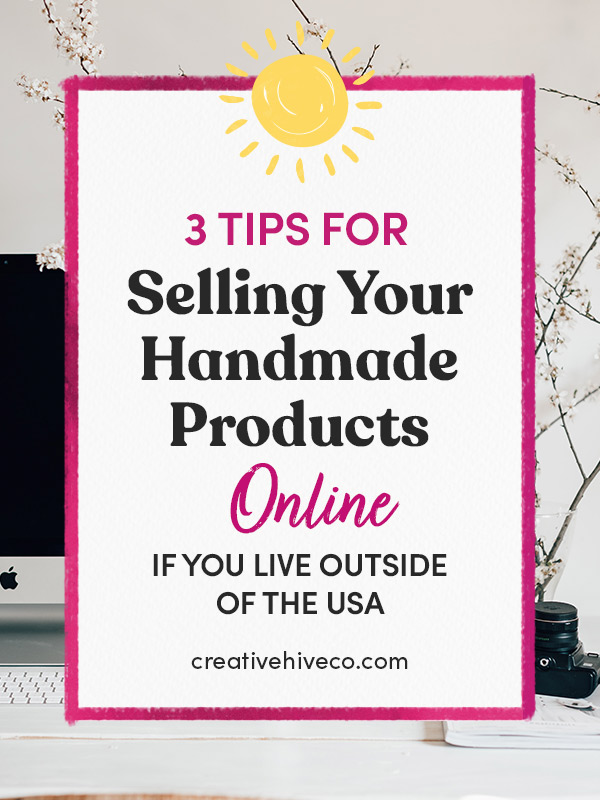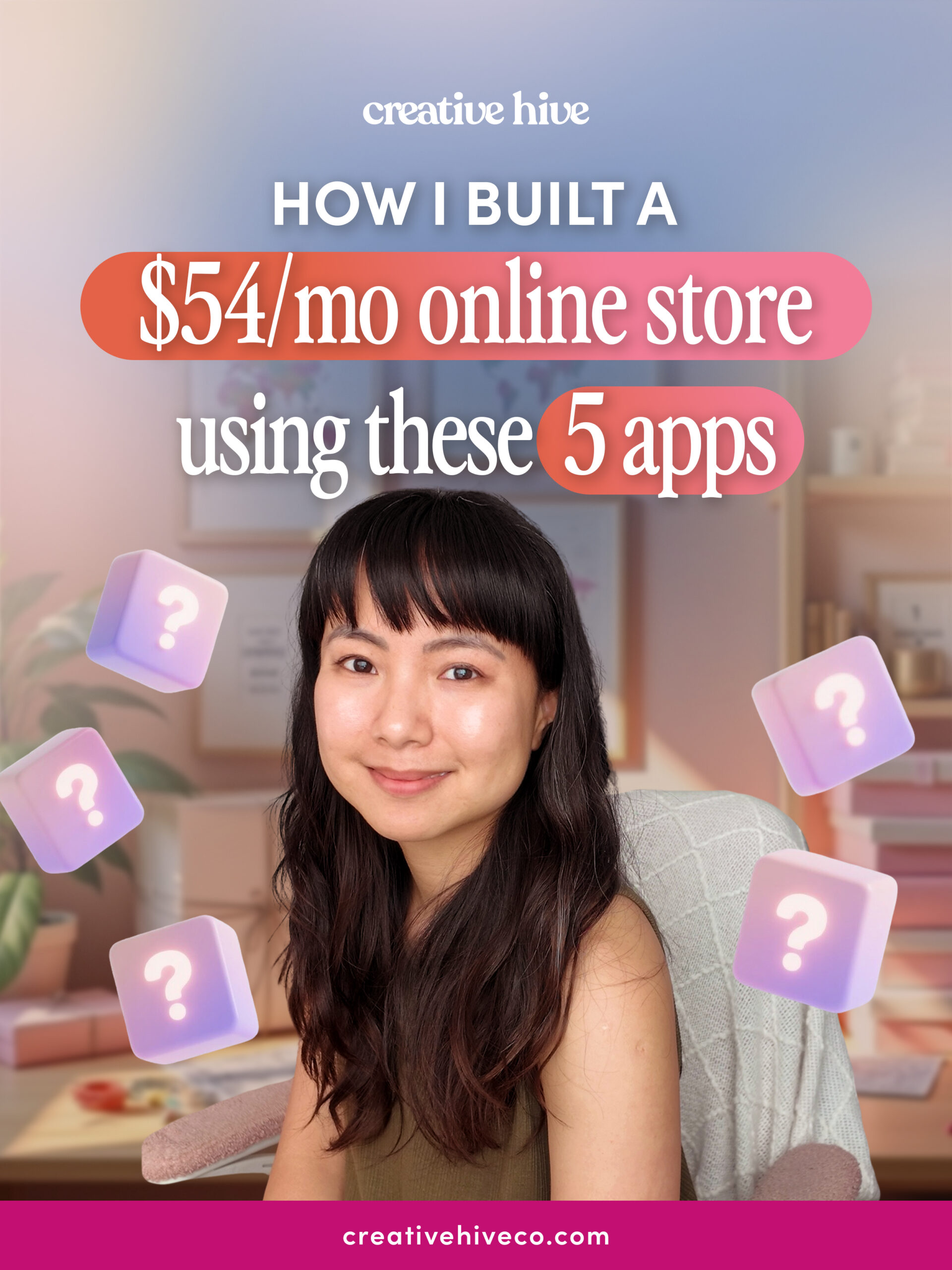3 Tips for Selling Your Handmade Products Online if You Live Outside of the USA
I want to help you build a sustainable, profitable handmade business that makes you consistent income and sales. I only ever teach or recommend marketing, social media, pricing, production and branding tips that I’ve personally used successfully in my own 7-figure handmade businesses.
I'm Mei, from Los Angeles!
Read More
Popular Posts You'll Love
Looking for something?
Categories
starting a business
get more traffic
running a business
make more sales
branding
growing a business
mindset & productivity
podcasts
pricing & money
product photography
reviews
selling on etsy
selling on amazon
social media
selling wholesale
- Facebook0
- Twitter3
- Pinterest8
- 11shares
Today I’m going to give you 3 crucial tips that you need to know for selling your handmade or physical products online when you’re based outside of the USA.
You may not know this about me, but I’m kind of new to the United States. I came to the US. for college, but I was born and raised in Malaysia. I even started my business there!
Most of my first few sales happened in Malaysia and I was selling primarily to customers in the US.
I should also mention that I do a fair bit of online shopping myself, and I’m a tiny person. I’m 5 foot 1, and I have tiny hands (which is why my business is called Tiny Hands).
Let me tell you, it’s really hard to buy clothes that fit me in the US, at least from the women’s section. Don’t tell anybody, but sometimes I go to the kids’ section.
Short people problems, am I right?
Needless to say, I’ve been a business operating outside of the US, I’ve bought a ton of stuff from non-US or international shops, and I get asked one question all the time from people who live outside the US but want to make their businesses work.
How do I sell my handmade products online if I live outside of the United States?
My quick answer to this is it doesn’t really matter. The top countries that spend the most money from online shopping are the United States, China and the United Kingdom.
Now, unless you can speak and write fluent Chinese, it’s not likely we’re going to hit the Chinese market anytime soon. So I highly recommend that you focus on selling to the US and UK.
I found a great research paper from World Retail Congress who published in 2019 that said,
“The US. is a formidable online force – it was the birthplace of the online marketplace and largely, Americans are very trusting online shoppers who have a high level of comfort shopping online. Around 79% of the population, or 258.5 million people, has made a purchase in the past year. This level of comfort is also evident in both the amount of money spent on average per shopper ($1951 USD annually) and the size of the overall US eCommerce market.”
This is what I’ve always told people. Americans are so comfortable shopping from international stores.
If you’re curious, China is first, but China is first with so many of these metrics because they’re just a huge country with a much larger population than the US.
My point with all those numbers is, regardless of what country you operate from, it’s likely that most of your online customers are going to be from the US.
If you’re serious about making sales online, then you’ll definitely want to focus on selling to people in the US. Otherwise, if you live in Canada and you only want to sell to Canadians, you’re going to be limited by a much smaller pool of people to sell to and that will make it harder to do well online.
So, if you want to be one of those stores we shop from, then continue reading to get my 3 tips for how to be successful selling your handmade products when you’re based outside of the US.
1. Trust
You want to make sure your brand conveys trust. This is super important for an international seller.
If you’re selling to the US, American sellers are always going to have small advantages over you. Their shipping is going to be cheaper and it’s going to get there faster, which already gives them a leg up.
What’s really important is that you, as an international seller, counteract that by having on-point branding.
That means not only having great graphics and great photos, but also making sure that you have reviews and social proof to build trust.
Ways you can build trust:
- Have a review plugin on your website
- Send out an email
- Asking for reviews from customers post-purchase
- Post customer photos on your social media or in your email newsletter
Another facet of building trust that’s super important is having error free product descriptions, especially if you are a non-native English speaker.
That means not only having error free descriptions in English, but also descriptions that match the tone of the customer that you’re trying to reach.
If this is especially challenging for you, you can find a copy editor that will go through and make sure your copy is good, on a site like Fiverr or Upwork. This cost, in my opinion, is so worth it!
I’m a terrible product description copywriter, and I had all of my jewelry’s copy written many years ago. It didn’t even cost that much, but my product copy is now an asset that just lives on forever. I don’t have to change or maintain it.
A final little component that builds trust is accepting widely used payment methods. Something like PayPal, which uses all credit cards also significantly improves someone’s trust.
I know a lot of people don’t like using Paypal as a shop owner, but my shop does 50% of all my sales from Paypal. So you should consider that you would be losing out on a lot of sales if you don’t offer Paypal.
2. Shipping
It’s really important to go through your shipping settings with a fine tooth comb. You’ll want to ensure accurate shipping information, accurate shipping price, and delivery times.
I encourage you to get really serious about how you charge for shipping.
As you start shipping internationally, small differences in weight or even box size can make a huge difference.
If you’re running your own website, there are plugins you can get that will accurately assess the shipping cost and allow you to charge exactly the right amount.
You definitely don’t want to be in a situation where you have a package to ship internationally, but it’s twice what you thought it was. Then you might be losing money on the sale.
Manage Expectations
In addition to getting your shipping streamlined between your website and your shipping system, you’ll want to go ahead and run a few test cases. This is where you attempt to ship to other countries.
This does a couple things.
- It makes sure that those systems are running smoothly.
- It gives you an idea of estimated delivery times.
Customers are really flexible and open about ordering from overseas. They know what to expect. But being able to accurately share expectations is really important here.
For example, I always tell my international customers that it takes anywhere from 2-8 weeks for their orders to arrive.
It usually gets there a lot sooner, but sometimes my packages get held up in customs and that can take a while.
As long as customers know what to expect, you won’t have any problems here.
Adjust Your “Ship To” Settings
If you’re using a third party site like Etsy, make sure your shipped-to countries are updated because that affects the search results and where you’re going to appear in the results.
If shipping is just super expensive to do with international packages, you have a couple of options here.
You can do some price tweaking by adding all or part of your shipping fees into your product prices.
One of the biggest turn offs for customers online is a high shipping price. It’s been proven that customers don’t mind a higher product price, if it means shipping is free or a very low cost.
But if your product price is low and your shipping price is high, people will most likely bounce from your site and not buy.
Using a Fulfillment Company
If you want to or you’re ready to grow big in the US. market, you might want to consider a fulfillment company.
You would basically ship a bulk package with multiple quantities of your products to a fulfillment company in the US.
They store your products and inventory and they do packaging and shipping for you. This cuts down on shipping prices per item, and your customers don’t have to pay too high of a shipping fee.
Plus it gets to your American customers a lot faster.
3. Product Information
You want to make sure that you’re including all of the relevant information that a person would need to get accurate information about your product, specifically if we’re talking about Americans.
Measurements
That means making sure to include imperial measurements, like inches and ounces.
If you want, you can include both metric and imperial measurements just so nobody feels left out.
It’s very easy to just use a calculator online, but most customers aren’t going to take the extra time to Google that information themselves. If they don’t see measurements in a metric they’re familiar with, they might leave your site without buying anything.
You want to make the purchase action as quick, seamless, and easy as possible.
Lifestyle Photos
Another thing that helps convey sizing information is lifestyle photos.
If you have a product that can be held in some hands or put in lifestyle settings, this gives the customer a very clear idea of the sizing.
Just make sure when you’re doing your photos, that you are thinking about items that are a great reference point all around the world.
Something that you may think is a great reference point, like your refrigerator, isn’t actually a good example because different countries have different standards for the size of a refrigerator.
Finding reference points that tend to be more universal, like a paperback book, a pencil, or an iPhone can be really useful.
Your Website
This leads me to your website. I want to mention this because I work with a lot of students in my A Sale A Day Business System program who have international shops whose mother tongues are a different language from English.
There’s a tendency to want to write your website in your country’s language and price your products in your currency, then use one of those currency converter plugins that allows the visitor to choose what currency and language to show the website in.
My take on this is it’s usually more work than is actually helpful for most.
I understand the need to be accessible to all customers from all countries, but most small business owners don’t pull off creating this experience well and they just end up creating too many hoops for every customer to jump through.
As a result, your conversion rate and sales are going to drop across the board.
For example, if your site is in French by default, and all the prices are in Euros, most Americans coming to your shop are going to be alienated.
In business, you have to accept and be comfortable that you cannot please everyone.
You should make your business decisions based on the majority of who your customers are, which most likely will be customers from the United States.
If you do decide to make your website user-friendly for different languages and currencies, really make sure you invest and commit to the best, most seamless solutions.
Going halfway or choosing the cheapest solution is only going to confuse your customers and lower your sales.
All of these tips are to help you on your business journey.
If you’re based outside of the US. and selling online, the bigger message is that it doesn’t really matter where you live. You can be successful even if you don’t live in the United States.
There might be a few more hoops for you to jump through, but the upside is the huge potential of sales you’ll get on the other side of it.
I hope you’ve enjoyed these tips on how to sell products online from outside the United States.
If you enjoyed this post or have any questions, leave a comment below.
Don’t forget to check out my YouTube channel for more tips and inside secrets!

Leave a Comment
Liked this article? Share it!
Unlock a Profitable Handmade Business
in Just 12 Weeks Without Using Etsy
or Social Media
FREE WORKSHOP
This workshop is for anyone who makes and sells a handmade or physical product, including jewelry designers, artists, paper designers, bath & body product makers and more!
What You'll Discover
The #1 mistake people make with Etsy & social media that causes shops to FLOP
The secret to making it with your handmade shop so it's no longer just a hobby
How to make sales in your handmade shop with ease so you can finally get to 6-figures
TAKE ME THERE
Your email address will not be published. Required fields are marked *
Leave a Reply Cancel reply
About
Blog
A Sale A Day
Student Login
Free Class
Contact
Terms
Become A Student
Watch On YouTube
Student Reviews
See My Handmade Shop!




Your blog post was thought-provoking and informative. I appreciated the way you presented the information and the connections you made to real-life examples. To gain further insights, click here.
I found your post to be well-structured and insightful. To delve deeper, click here.
I am a women entrepreneur from İstanbul. I make upcycled denim bags from old jeans.
I want to sell my products to physical concept stores in the USA or in Europe.
How can I get this happen?
Thanks for now
Gül Semiz
Hello I really want what you explained here.Please I need to talk to you I have many question and issues trying to sell online.